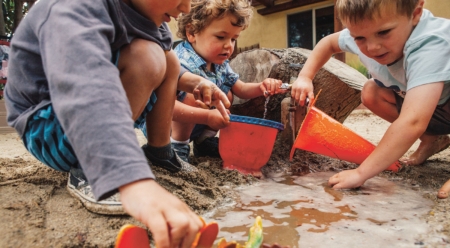Why is Unstructured Play Crucial?
Patagonia has offered corporate-sponsored on-site childcare since 1983. The Great Pacific Child Development Center, GPCDC for short, is where infants and children spend their days crawling, running, climbing and exploring, mostly outdoors, while their parents work. We wanted to tell the story of GPCDC, so last year we published Family Business by Malinda Chouinard and Jennifer Ridgeway. The book illustrates what high-quality childcare looks like and explains why providing on-site childcare to working families is at the heart of responsible business today. The following is another in our series of excerpts from Family Business; it’s Chapter Five, “Creative Play.”
Chapter Five: Creative Play
Unstructured play, where children get messy and wild, where the unpredictability of nature is available to surprise and delight, is the pinnacle of play. In a world that often expects children to put aside “childish ways” in favor of “preparing” for the future, we stand for the right of children to play, because we know that play is how children prepare for the future. We are not alone in this belief. Experts of all stripes have stated that play is an essential part of a healthy childhood. According to pediatric occupational therapist Angela Hanscom, if children don’t get enough unstructured playtime, “They are more likely to be clumsy, have difficulty paying attention, trouble controlling their emotions, utilize poor problem-solving methods, and demonstrate difficulties with social interactions.”
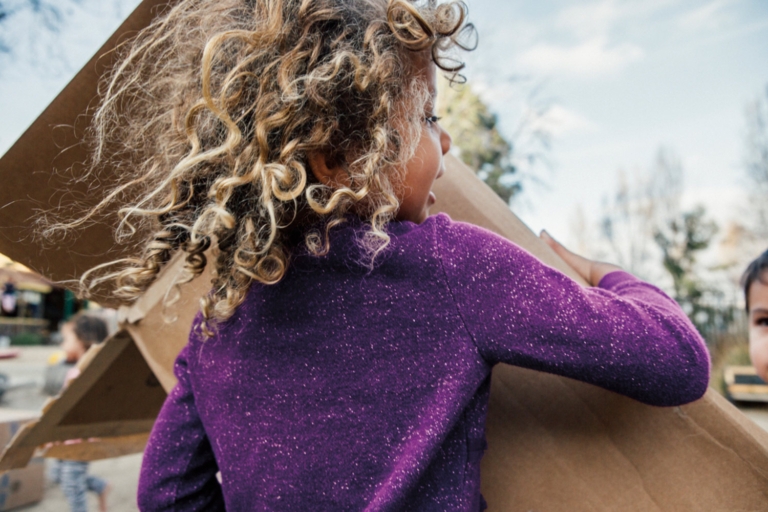
Photo: Kyle Sparks
What is Play?
Although play is easy to identify, it turns out that defining play is actually difficult. Many researchers have labeled different kinds of play and characterized what qualities constitute play. Here are a few elements that we believe are part of good play: Play is fun. Children do it for the satisfaction of playing. Even if children have a goal, such as “Let’s climb to the top of the tree,” the journey is more important than the destination. Children freely choose to play and are actively engaged, whether physically, verbally, or through observation. Finally, play is imaginative and doesn’t need to reflect reality.
When children play, the teacher’s role is to step back and observe.
Play flourishes when adults support it in a skillful and subtle manner. If adults are too involved and directive, play deteriorates. Our children direct their own play. Teachers support play by setting up environments that reflect kids’ interests. When conflict arises or children have difficulty starting to play, they support them in a variety of ways. For the most part, teachers act as mentoring guides; they observe as the rich world of children’s play unfolds.
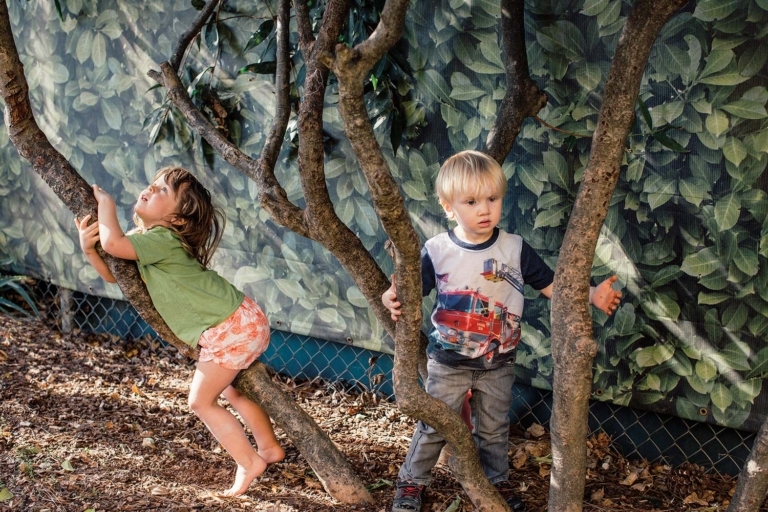
Photo: Kyle Sparks
The foundation of play is exploration.
Whether kids are climbing trees, hunting for bugs, or pretending to fly to the moon, exploration is central to play. Infants play by exploring their hands, fingers, and toes. Toddlers leave no stone unturned. All kids use play to investigate their senses and delve into relationships. Children are inherent explorers—curious about the unfamiliar and interested in challenges. We strive to keep them that way.
Our teachers have an eye for simple items that can be transformed into experiences, plus we have a sewing room, design studio, café, and retail store—all of which can serve as sources for reusable raw materials, including fabric remnants, cardboard boxes, and long tubes from fabric bolts. Children’s interests unfold best in their play when they are fashioning toys out of found objects, rather than commercial toys.
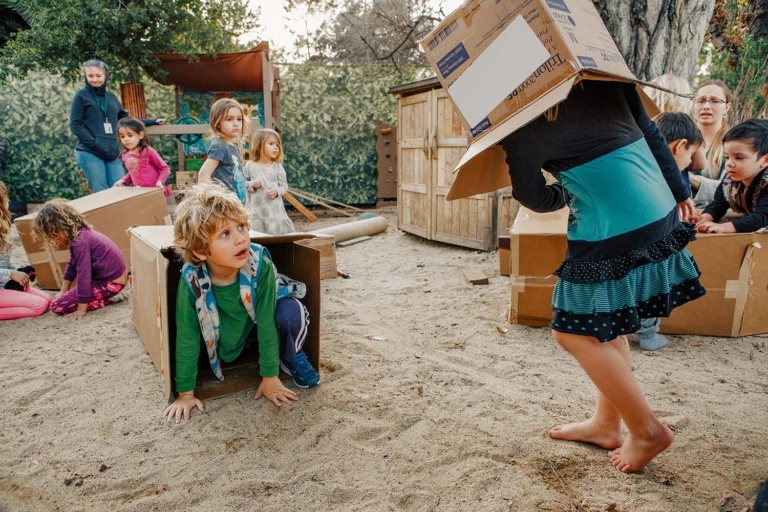
Photo: Kyle Sparks
Wild play develops imagination and creativity.
Most of us spent our childhoods being told “Go outside and play.” Once outside, we used our imagination and creativity to figure out what to do. Children today, entertained by electronics, are staying indoors. To combat this trend, we look to the adventure playground movement, founded 80 years ago by a Danish architect. Adventure playgrounds are stocked with wood, loose parts, and tools. Risk, ingenuity, and independence abound as kids build their own equipment. In our play yards, we combine loose parts and tools with natural landscapes and a respect for kids’ independence to create a place where children can go truly wild. This wild play has an important role in all areas of development. Many believe that playing outside has a positive impact on manual dexterity, depth perception, physical coordination and tactile sensitivity.
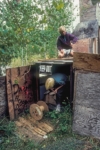
Photo: David Wheelock
Constructive play is rich with thought and inventiveness.
Carl Jung astutely observed that “The creation of something new is not accomplished by the intellect but by the play.” Constructive play is a rich form of play because it engages children’s minds, hands, and imaginations. To build something new and different, kids must think mathematically, then create stories about what they’re building, and negotiate particulars with others. There are physical challenges as children balance pieces or place tiny details. Teachers just need to provide compelling materials—children will not only build fantastic structures but also life skills.
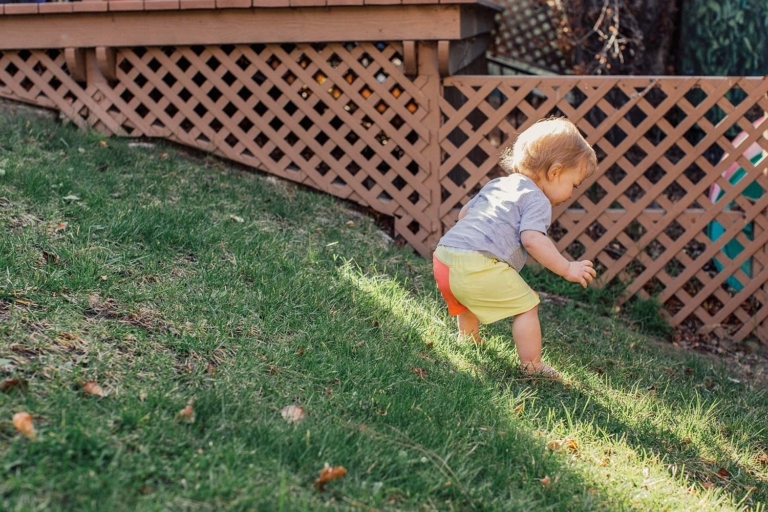
Photo: Kyle Sparks
Play can be challenging.
When did you last recruit friends and entice them to play a role in a game complex enough to be interesting but simple enough to follow? Sound easy? It’s not. Play is difficult. Objects are unruly. Everyone wants things to go their way. What you imagine is often impossible to achieve. Sometimes frustration motivates kids to solve problems. Other times, it can be too much. By learning children’s cues, teachers know when to provide minimal support that still allows children to experience self-reliance while achieving their goals.
Teachers also keep in mind that when children play games where everything goes according to plan, they quickly drift away. The goal of play isn’t racing to the finish but relishing the journey. We are inspired by the adventure playground movement, which encourages providing children with tools and a plethora of building materials so they can create their own challenges.
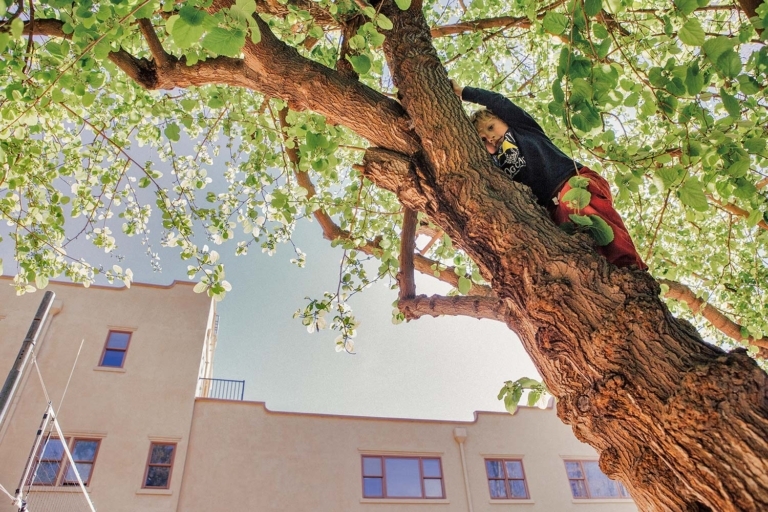
Photo: Kyle Sparks
The value of unstructured play.
The value of unstructured play is best summarized by filmmaker Erin Davis, who recently completed a documentary called The Land, which is about an adventure playground in North Wales. “Kids now are the same as they ever were, and have been throughout time. They climb things, they hide in things, they create dens and places to hide in, create hierarchies and worlds of their own. They’re drawn to fire; they’re super-imaginative. What’s different [today] is the degree to which they have an opportunity to express and pursue these interests. So it’s surprising to us—but really it shouldn’t be—that kids thrive in these environments when they can do really whatever they want. They have the play drive. It’s up to us to provide the kinds of opportunities for them to really follow through on it.”
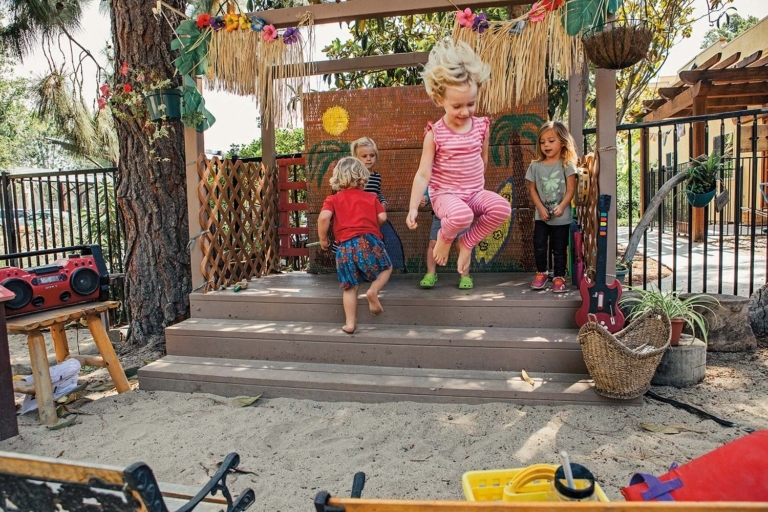
Photo: Kyle Sparks
Physical play is body centered: running, jumping, and climbing.
While physicality is always part of play, the term “physical play” is defined by body-centric play. It’s rolling, running, jumping, chasing, and leaping for the sake of movement itself. According to a research summary by the Minnesota Children’s Museum, “Despite the potential physical and cognitive benefits bestowed by physical activity, physical play is one of the least researched forms of play. It is also one of the most endangered forms of play in our schools and society: Recess in schools is disappearing at an alarming rate, and active play among youngsters has plummeted by 50 percent over the last 40 years.”
Social play helps build community.
While all children, even babies, play with others, social play becomes a priority in the preschool years. But it’s not only the way children develop social skills; it’s the way they build community. Our teachers encourage pro-social behaviors, including empathy, cooperation, and helpfulness in group play. For children, playing together is intimate and sacred, and it’s the time when they reveal their innermost thoughts and feelings.
Pretend play peaks in preschool and starts to wane in middle childhood.
Children who are about a year old will use their bodies to pretend to do things like sleep and eat. Two-year-olds will transform objects—a banana becomes a telephone, and a ball turns into an apple. Eventually, children use fewer props and are able to be more abstract so that all the world becomes a stage. When kids play firefighters, mothers, and butterflies, they process life and take on new identities. The child afraid of monsters becomes a superhero to save her friends from evil, feeling courageous and reassured that she has power over her fears. The day she decides to be the monster, she discovers we all have a little monster inside and by embodying it, the monsters outside aren’t quite as scary.
Children forge their own reality in fantasy play.
In The Boy Who Would Be a Helicopter, Vivian Gussin Paley observes that “‘Pretend’often confuses the adult, but it is the child’s real and serious world, the stage upon which any identity is possible and secret thoughts can be safely revealed.” In fantasy play, children both re-create reality and construct imagined worlds. Teachers supply the materials for both. Kids get uninterrupted time to build play scripts and act out their ideas. Sometimes teachers label emotions expressed, ask exploratory questions, and offer materials to expand pretend play.
Kids imitate what adults say and do.
For better or worse, imitation is how culture is transmitted. Children use play as a form of imitation, as the photos on these pages demonstrate. For example, when children have a new sibling in the family, playing out domestic rituals from home can help them process the change. Pretending to cook and clean are favorite games among two- and three-year-olds and speaks to their desire to be independent, industrious, and model adults’ behaviors. Through close observation of play, we can track how children are interpreting what adults do. As a result, our teachers use the same language with each other that they teach children. Teachers also play with an attitude of wonder and awe. They honor agreements, eat healthy foods, and compost leftovers. Children will always find unrefined bits of adult behavior and reflect them back, often through play. When they do, we do our best to improve our conduct. If we want to change culture by influencing the next generation, we’ve got to, as they say, be the change we want to see.
Play is joyful.
Given all of the benefits and intricacies of play, it can be easy to forget that at its core, play is a source of joy. We never want to lose sight of the fact that play is fundamentally joyful. Teachers and children share joyful moments, and teachers identify the emotions: “I see you smiling as you and Anna ride that scooter.” Children have always played, and despite being overscheduled and inundated with technology, they continue to do so. Play brings meaning to kids’ lives. It connects them to friends, family, animals, places, and ideas. It’s the way they discover and create themselves. Protecting play—wild, imaginative, creative play—is an important responsibility that we take on wholeheartedly.

Family Business: 30 Years of Innovative On-site Child Care, by Malinda Chouinard and Jennifer Ridgeway
Learn more about the Family Business project, watch a series of videos about working families and buy the book at patagonia.com.
